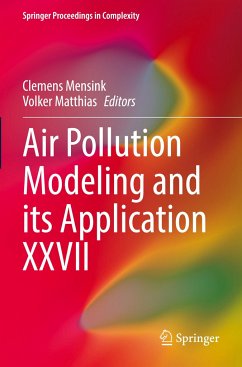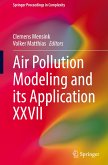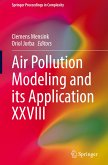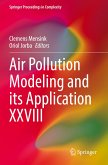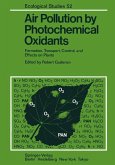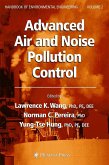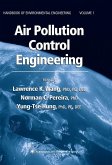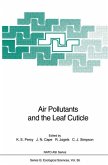Air Pollution Modeling and its Application XXVII
Herausgegeben:Mensink, Clemens; Matthias, Volker
Air Pollution Modeling and its Application XXVII
Herausgegeben:Mensink, Clemens; Matthias, Volker
- Broschiertes Buch
- Merkliste
- Auf die Merkliste
- Bewerten Bewerten
- Teilen
- Produkt teilen
- Produkterinnerung
- Produkterinnerung
This book is intended as reference material for students and professors interested in air pollution modeling at the graduate level as well as researchers and professionals involved in developing and utilizing air pollution models. Current developments in air pollution modeling are explored as a series of contributions from researchers at the forefront of their field. This newest contribution on air pollution modeling and its application is focused on local, urban, regional and intercontinental modeling; emission modeling and processing; data assimilation and air quality forecasting; model…mehr
Andere Kunden interessierten sich auch für
![Air Pollution Modeling and its Application XXVII Air Pollution Modeling and its Application XXVII]() Air Pollution Modeling and its Application XXVII147,99 €
Air Pollution Modeling and its Application XXVII147,99 €![Air Pollution Modeling and its Application XXVIII Air Pollution Modeling and its Application XXVIII]() Air Pollution Modeling and its Application XXVIII161,99 €
Air Pollution Modeling and its Application XXVIII161,99 €![Air Pollution Modeling and its Application XXVIII Air Pollution Modeling and its Application XXVIII]() Air Pollution Modeling and its Application XXVIII161,99 €
Air Pollution Modeling and its Application XXVIII161,99 €![Air Pollution by Photochemical Oxidants Air Pollution by Photochemical Oxidants]() Air Pollution by Photochemical Oxidants77,99 €
Air Pollution by Photochemical Oxidants77,99 €![Advanced Air and Noise Pollution Control Advanced Air and Noise Pollution Control]() Advanced Air and Noise Pollution Control162,99 €
Advanced Air and Noise Pollution Control162,99 €![Air Pollution Control Engineering Air Pollution Control Engineering]() Air Pollution Control Engineering220,99 €
Air Pollution Control Engineering220,99 €![Air Pollutants and the Leaf Cuticle Air Pollutants and the Leaf Cuticle]() Air Pollutants and the Leaf Cuticle110,99 €
Air Pollutants and the Leaf Cuticle110,99 €-
-
-
This book is intended as reference material for students and professors interested in air pollution modeling at the graduate level as well as researchers and professionals involved in developing and utilizing air pollution models. Current developments in air pollution modeling are explored as a series of contributions from researchers at the forefront of their field. This newest contribution on air pollution modeling and its application is focused on local, urban, regional and intercontinental modeling; emission modeling and processing; data assimilation and air quality forecasting; model assessment and evaluation; aerosol transformation. Additionally, this work also examines the relationship between air quality and human health and the effects of climate change on air quality.
This work is a collection of selected papers presented at the 37th International Technical Meeting on Air Pollution Modeling and its Application, held in Hamburg, Germany, September 23-27, 2019.
This work is a collection of selected papers presented at the 37th International Technical Meeting on Air Pollution Modeling and its Application, held in Hamburg, Germany, September 23-27, 2019.
Produktdetails
- Produktdetails
- Springer Proceedings in Complexity
- Verlag: Springer / Springer Berlin Heidelberg / Springer, Berlin
- Artikelnr. des Verlages: 978-3-662-63762-3
- 1st ed. 2021
- Seitenzahl: 392
- Erscheinungstermin: 14. November 2022
- Englisch
- Abmessung: 235mm x 155mm x 22mm
- Gewicht: 593g
- ISBN-13: 9783662637623
- ISBN-10: 3662637626
- Artikelnr.: 66205899
- Springer Proceedings in Complexity
- Verlag: Springer / Springer Berlin Heidelberg / Springer, Berlin
- Artikelnr. des Verlages: 978-3-662-63762-3
- 1st ed. 2021
- Seitenzahl: 392
- Erscheinungstermin: 14. November 2022
- Englisch
- Abmessung: 235mm x 155mm x 22mm
- Gewicht: 593g
- ISBN-13: 9783662637623
- ISBN-10: 3662637626
- Artikelnr.: 66205899
Prof. Dr. Ir. Clemens Mensink is the head of the environmental modeling unit at VITO in Belgium. The unit employs more than 100 researchers, ICT professionals and technicians. They develop, improve and implement methodologies and computer models to estimate the impact of human activities on air, water and soil quality in a spatial context. Clemens received his Ph.D. (1992) and a postgraduate degree (1988) in fluid dynamics from the Von Karman Institute in Belgium. He studied fluid mechanics, numerical mathematics and chemical engineering, and received his M.Sc. (1987) in mechanical engineering from the University of Twente in the Netherlands. In 1998, he received the ENERO prize. Clemens is currently president of the International Technical Meeting on Air Pollution Modeling and its Applications. He is an expert in air pollution modeling and the author of more than 80 peer-reviewed publications in international journals. He is lecturing Air Pollution Modeling at Ghent University (postgraduate studies in Weather and Climate Modeling) and University of Hasselt. Dr. Volker Matthias is head of the chemistry transport modelling department at Helmholtz-Zentrum Hereon, Germany. The department develops and applies emission models as well as regional and city scale atmospheric model systems to study matter transport and air pollution in coastal areas. Volker studied physics at the University of Hamburg and did his PhD in Meteorology at the Max-Planck-Institute for Meteorology in Hamburg in 2000. Since 2003 he is employed at Helmholtz-Zentrum Hereon. His research focus is on emissions, transport and transformation of pollutants in the atmosphere. Since several years, ship emissions are an important aspect of his work. He is author of more than 80 peer reviewed publications. He is teaching Atmospheric Chemistry at the University of Hamburg as well as Transport of Matter in the Environment and Model Systems in Global Change Research at Leuphana University Lüneburg. He has guided several PhD, Master and Bachelor students.
Role of Organic Aerosol Chemistry Schemes on Particulate Matter Modelling in Europe.- Biogenic Emissions and Urban Air Quality.- Global Simulations of Ice Nuclei Particles Derived from Organics and Inorganics Particles.- Estimating Aerosol Loads and Aerosol-cloud-interaction in the 1980s and Today.- Characterisation of Light-absorbing Particles in the Brussels Sub-urban Atmosphere and Implications for the Emission Scheme of a Regional Chemical Transport Model.- Traffic Emissions 2040 - Impact on Air Quality in Germany.- Biogenic VOC Emission Modelling for Spain: Adaptation of the National Forest Inventory as Input for MEGANv3.- Alteration of Vehicle Propellant Use and the Impact on CO2 Emissions and NO2 Concentrations in Gothenburg and Mölndal.- Improvements of Chemical Transport Modelling Over the Last 40 Years - a Personal Journey.- Timely Update of Emission Inventories with the Use of Satellite Data.- Modelling Atmospheric Composition in the Summertime Arctic: Transport of North American Biomass Burning Pollutants and their Impact on the Arctic Marine Boundary Layer Clouds.- Effect of Aerosol Nitrate Photolysis on Wintertime Air Quality.- Improved Estimation of Background Ozone and Emission Impacts Using Chemical Transport Modelling and Data Fusion.- Same Model (CAMx6.50), Same Year (2010), Two Different European Projects: How Similar are the Results?.- SMART Modelling Suite: Assessment of the Turbulence Parameterisation for the Simulation of Atmospheric Circulation and Dispersion.- Analysis of the Zero-out Method of Source Apportionment for Air Quality Modelling in Spain.- Spatio-temporal Modelling of Grass and Birch Pollen in Belgium.- Multi-compartment Chemistry Transport Models.- Climate Change Projections for Bulgaria According to RCP45 Scenario Until 2099.- Interpreting Measurements from Air Quality Sensor Networks: Data Assimilation and Physical Modelling.- Need and Potential Benefits of Improving Aloft Air Pollution Characterization: A Modeling Perspective.- Optimal Interpolation Based Data Fusion Techniques to Improve Deterministic Air Quality Forecast.- Eigenmode-based Parameter Perturbation for Stochastic Chemistry Transport Modeling.- Evolution of the Performance of the Canadian Operational Regional Air Quality Deterministic Prediction System from 2010 to 2019.- Statistical Methods to Forecast Air Quality in Taipa Ambient and Taipa Residential of Macao.- Impacts of Fine Particulate Matter and Climate Change on Human Health Over Europe - Present and Future Scenarios.
Role of Organic Aerosol Chemistry Schemes on Particulate Matter Modelling in Europe.- Biogenic Emissions and Urban Air Quality.- Global Simulations of Ice Nuclei Particles Derived from Organics and Inorganics Particles.- Estimating Aerosol Loads and Aerosol-cloud-interaction in the 1980s and Today.- Characterisation of Light-absorbing Particles in the Brussels Sub-urban Atmosphere and Implications for the Emission Scheme of a Regional Chemical Transport Model.- Traffic Emissions 2040 - Impact on Air Quality in Germany.- Biogenic VOC Emission Modelling for Spain: Adaptation of the National Forest Inventory as Input for MEGANv3.- Alteration of Vehicle Propellant Use and the Impact on CO2 Emissions and NO2 Concentrations in Gothenburg and Mölndal.- Improvements of Chemical Transport Modelling Over the Last 40 Years - a Personal Journey.- Timely Update of Emission Inventories with the Use of Satellite Data.- Modelling Atmospheric Composition in the Summertime Arctic: Transport of North American Biomass Burning Pollutants and their Impact on the Arctic Marine Boundary Layer Clouds.- Effect of Aerosol Nitrate Photolysis on Wintertime Air Quality.- Improved Estimation of Background Ozone and Emission Impacts Using Chemical Transport Modelling and Data Fusion.- Same Model (CAMx6.50), Same Year (2010), Two Different European Projects: How Similar are the Results?.- SMART Modelling Suite: Assessment of the Turbulence Parameterisation for the Simulation of Atmospheric Circulation and Dispersion.- Analysis of the Zero-out Method of Source Apportionment for Air Quality Modelling in Spain.- Spatio-temporal Modelling of Grass and Birch Pollen in Belgium.- Multi-compartment Chemistry Transport Models.- Climate Change Projections for Bulgaria According to RCP45 Scenario Until 2099.- Interpreting Measurements from Air Quality Sensor Networks: Data Assimilation and Physical Modelling.- Need and Potential Benefits of Improving Aloft Air Pollution Characterization: A Modeling Perspective.- Optimal Interpolation Based Data Fusion Techniques to Improve Deterministic Air Quality Forecast.- Eigenmode-based Parameter Perturbation for Stochastic Chemistry Transport Modeling.- Evolution of the Performance of the Canadian Operational Regional Air Quality Deterministic Prediction System from 2010 to 2019.- Statistical Methods to Forecast Air Quality in Taipa Ambient and Taipa Residential of Macao.- Impacts of Fine Particulate Matter and Climate Change on Human Health Over Europe - Present and Future Scenarios.

